Featured in Horticulture
April 19, 2010 by admin
Filed under Cottage Gardening
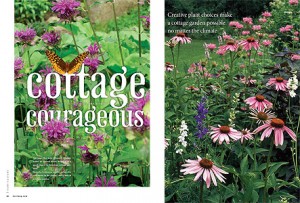
All you Horticulture magazine readers out there may already have noticed a certain familiar cottage garden in the May issue. Yup—that’s my baby, the same garden I showcase in my Connecticut Cottage Garden lecture, and the same one you’ve seen here in some other posts under the Cottage Gardening heading.
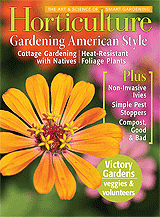 Writing the article was a good exercise for me, because it forced me to focus and condense all the ideas I want to convey about cottage gardening into a few broad principles, which themselves all boiled down to one overarching piece of advice: use the plants that are best suited to your climate, your available time, energy and budget, and your specific site. Sometimes you can only discover what those are by trying something out, but most of the time it’s pretty predictable what will work and what won’t.
Writing the article was a good exercise for me, because it forced me to focus and condense all the ideas I want to convey about cottage gardening into a few broad principles, which themselves all boiled down to one overarching piece of advice: use the plants that are best suited to your climate, your available time, energy and budget, and your specific site. Sometimes you can only discover what those are by trying something out, but most of the time it’s pretty predictable what will work and what won’t.
The basic problem is that you can’t take the traditional English cottage garden plant palette, plunk it down wholesale in the Northeast and expect it to work. As I often say, England and New England may have a name in common, but when it comes to gardening the resemblance is strained.
The English climate (although of course it varies) is milder, cooler and more predictable than ours, which makes their plant palette more extensive. There, many plant diseases are easier to control precisely because the English climate is not as conducive to their development. And for the love of Pete, they don’t even have Japanese beetles! It really is easier to garden there!
One subject I cover in the article that I haven’t broached yet in this blog is the idea that you’ll save yourself a lot of unnecessary heartache, not to mention time and money, if you don’t get too hung up on growing traditional cottage garden plants if they just don’t do well here, for whatever reason. Instead, look for reasonable substitutes that are reliable.
Here’s one example. Early in my cottage garden’s history, I planted a number of reblooming shrub roses. Bad idea. Not only were they Japanese beetle magnets, but they also had a hard time fending off their neighbors. I intentionally included a lot of large, leafy perennials in my cottage garden because their height and mass give the space privacy and separation from some busy surroundings. All well and good, but everyone knows roses don’t like crowding. They suffered, and eventually I removed them.
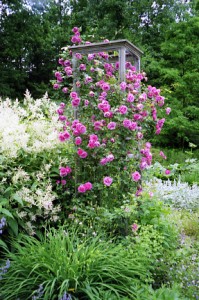
Rosa 'Cl. American Beauty' living up to her name.
But one rose remained and has been a highlight of the garden right from the start. Ironically, it was moved there from another garden where it wasn’t getting enough light. While the other roses declined, it found its stride and developed into a stunning specimen. It’s a ‘Cl. American Beauty,’ and you can see in the photo at left how impressive it can be.
So what made this one rose different? Several things. First, it’s a climbing rose. I grow it on an 8′ tall cedar pillar with hardware cloth sides. Grown that way, most of its foliage is up above the plants that surround it instead of struggling to grow out from underneath. Plus, the open structure of the pillar promotes air circulation, which discourages disease.
Second, it’s an early flowering, once-blooming rose. Your first reaction might be disappointment, but it shouldn’t be. It’s true that this rose will bloom for a shorter time than reblooming roses. However—and this is an important however—it blooms during the first three weeks of June, before the Japanese beetles emerge! I may get only three weeks of flowers, but I get three weeks of perfect, unmolested flowers with no nasty holes gnawed into the buds. I’ll take that any day over months of half chewed, pesticide soaked flowers on rebloomers.
It should go without saying that ‘Cl. American Beauty’ is naturally quite disease resistant and cold hardy in Connecticut. You should always select perennial and woody plants for cold hardiness and disease resistance.
Now, some of you might say that a once-blooming rose isn’t an alternative to a traditional cottage garden plant—it is a traditional cottage garden plant! And you’d be half right. Although ‘Cl. American Beauty’ is a cross introduced in the early 1900s, it has more in common with truly old roses than it does with most modern ones. The point is that a lot of gardeners either might not know or might not make the time to find out what kind of rose is most likely to succeed in a given garden. They’d just go to a nursery and pick one they liked. That’s understandable, because it’s easy to have your socks knocked off by some trendy plant fresh from the grower looking better than it ever will again because of all the protection, coddling and extraordinary care it’s received. Can you give it that same level of care? Probably not. Better to choose something that doesn’t need all that extra care.
My ‘Cl. American Beauty’ doesn’t need to be sprayed with fungicides, and it doesn’t require that I take any measures against Japanese beetles. Oh, and by the way…its fragrance is heavenly! As roses for cottage gardens go, I couldn’t ask for more.
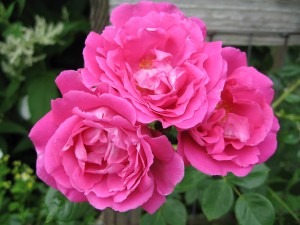
Let Self-Sowers Do the Work for You
September 24, 2009 by admin
Filed under Cottage Gardening
What is it that gives cottage gardens their special joie de vivre? It’s a question I explore in depth in my new lecture, A Connecticut Cottage Garden: Adapting a Classic Garden Style to the Northeast. (Click here for my lecture schedule.)
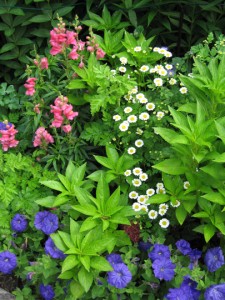
Cottage gardens feature many kinds of delightfully intermingled plants.
The answer to the question actually has many parts. First, cottage gardens are packed with plants. That’s right—they’re just plain crowded, with plants tumbling over one another in a free-for-all attempt to reach the light.
Variety, too, is important. I once estimated that a small cottage garden I made had about 150 different kinds of plants.
So, it’s no wonder that cottage gardens seem to burst with life, or that there’s always something new happening. Put enough plants, and enough different plants, together in one place, and an overflowing, ever changing garden is practically inevitable.
But that’s not quite the whole story. Part of the cottage garden look is a certain accidental-on-purpose feel they have. But how to create that effect?
Funny as it sounds to say, “accidental-on-purpose” is actually not that hard to do. The key is self-sowing plants.
The term “self-sowing plant” is pretty self-explanatory. It’s a plant that spreads more or less readily by seed. It can be annual or biennial or even perennial, although most effective self-sowers fit into the first two categories just because annuals and biennials bloom a short time after germinating, whereas many perennials have to be 2-3 years old before they start flowering.
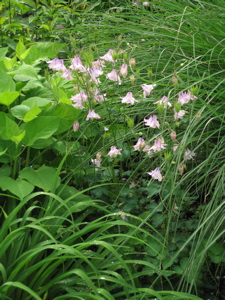
A self-sown columbine looks perfect where it chose to grow.
The magic of self-sowing plants is that they decide where they’ll grow. More than once, I’ve had the experience of finding a self-sown plant in a spot where it looks perfect (although I had nothing to do with it being there), and I’ve wondered, “Why didn’t I think of that?” It’s humbling.
On a more quotidian level, self-sowers are great because they’re huge time and work savers. Think how much effort it would take to start 200 foxglove seedlings in pots and then transplant them all into the garden individually. But by spreading foxglove seed in the garden, I might easily get hundreds of plants the following year with nothing more than a few minutes of time expended.
After the first generation of plants is established, they’ll distribute their seed throughout the garden with no further help from me, eventually giving rise to a stable population of plants that replace themselves as parent plants die out. If they propagate themselves a little too enthusiastically, I always have the option of culling seedlings, but that’s a lot easier than germinating and planting them.
How else do self-sowing plants make a gardener’s life easier? Well, think about the spots that are just too hard to plant manually, such as the joints between flagstones. Self-sowers can fill these tiny nooks and crannies easily—you just have to be patient. And again, when something inappropriate comes up—say, a five-foot plant in the middle of a narrow pathway—you can remove it.
At their best, self-sowers represent the combination of the gardener’s genius and the garden’s genius: the gardener provides the raw material and the garden runs with it, but the gardener always gets the last word.

Forget-me-not is a classic cottage garden self-sower.
Many classic cottage garden plants are self-sowers. Honesty (Lunaria, also called “money plant”), foxglove (Digitalis), columbine (Aquilegia), flowering tobacco (Nicotiana), feverfew (Tanacetum parthenium, which I prefer in the gold-leaved form ‘Aureum’), Johnny jump-ups (Viola tricolor) and forget-me-not (Myosotis sylvatica) are just a few examples.
Late summer and early autumn is the perfect time to spread seed of most self-sowing plants. It makes sense, because if the plants were already growing in your garden, now is when their seed would be maturing. The seeds of annuals may not start growing until next spring, but getting them in the garden now is a good idea because they’ll be perfectly positioned to take advantage of late winter’s abundant moisture to get them off to a good start.
Biennials probably will germinate now and produce a bit of leafy growth before hunkering down for the winter. In fact, this autumn’s growth will count as their “first year,” so they’ll flower next spring or summer even though they’re less than two years old by the calendar. This is why biennials will flower in your garden every year rather than every other year once they’re established; their age is measured in growing seasons, not calendar years.
If you’ve never grown self-sowing plants before, there are a couple of things you’ll have to get used to. Because most good self-sowers are annuals or biennials, they tend to move around a lot. An annual or biennial parent plant dies off after one or two seasons, and its offspring come up where they will. In many gardens, it would be an annoyance if a plant picked up and moved. In a cottage garden, it’s just charming.
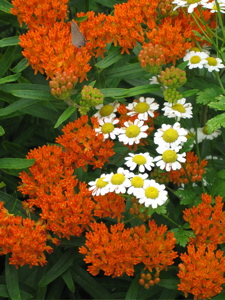
I always put golden feverfew next to butterfly weed if it doesn't seed itself there.
Besides, you can always move a few seedlings if you have your heart set on a plant growing in a particular spot. I do this as needed with golden feverfew, because I always want some growing next to my Ligularia przewalskii, my daylily (Hemerocallis) ‘Bertie Ferris’ and my butterfly weed (Asclepias tuberosa). You’ll discover your own favorite combinations.
Also, you can’t predict just how much of a self-sowing plant you’ll have in any given year. Depending on weather and other conditions, you might have very few specimens of a particular plant one year and a population explosion the next. I’ve learned to accept that sometimes there’s no point trying to figure out why—only the plant knows what motivates it.
Other plants will be consistently abundant. In that case, it’s important to draw a line between unstructured and chaotic in the garden. Be ruthless in removing excess seedlings, or you may regret it later. Morning glory became unmanageable in one of my gardens, and I banished it (although that task took several years). Remember, you’re trying to save yourself work, not create more of it. Deal with problem plants before the situation gets out of hand.
Conversely, a plant you treasure may never self-sow as much as you want in your garden. In that case, just help it along by strewing some additional seed each autumn. I have to do that with foxglove in one garden I keep or it will eventually die out.
There’s one last point I want to make about self-sowing plants, and that’s that they aren’t appropriate in every setting. Non-native self-sowing plants shouldn’t be used where they are likely to escape into the wild. That means keeping them away from uncultivated areas and other people’s property.
I once read an article about a self-sown urban front yard garden. I hope the author’s neighbors had the same taste he did, because it’s 100% certain that they got some of his plants. So be courteous and responsible when deciding to use self-sowers—they can become a nuisance to other people and/or a problem in the environment. I think it’s just a matter of ecological responsibility and neighborliness.
So get a head start on next year by experimenting with a few self-sowing plants in your cottage garden. Below is a list of some good candidates that shouldn’t be too hard to find in seed form. I encourage you to try several to increase your chances of success. Don’t be disappointed if a few don’t work. The essence of the cottage gardening spirit is letting the garden express its personality, too. Love what works, and let what doesn’t go.
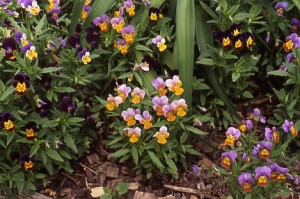
Johnny jump-ups fill in garden nooks and crannies all by themselves.
Columbine (Aquilegia)
Spider flower (Cleome hassleriana)—Potentially invasive, so thin it out if necessary.
Larkspur (Consolida)
Cosmos (Cosmos bipinnatus and C. sulphureus)
California poppy (Eschscholzia californica)—Prefers dry conditions.
Sunflower (Helianthus annuus)
Balsam impatiens (Impatiens balsamina)
Sweet alyssum (Lobularia maritima)
Honesty (Lunaria annua)
Forget-me-not (Myosotis sylvatica)—Potentially invasive, even in wooded areas. Will form a low carpet of flowers in May.
Perilla (Perilla frutescens)—Potentially invasive; deadhead at least some of the crop to keep it under control-you’ll grow this for its purple leaves, anyway.
Poppies (various Papaver)
Johnny jump-up (Viola tricolor)
8 Great Native Cottage Garden Perennials Part I
April 19, 2009 by admin
Filed under Cottage Gardening
Welcome to the first in my “8 Great” series! Each “8 Great” list will present eight plants that have something in common that’s of interest to gardeners. They might be good for shade or late summer interest or a particular set of soil conditions—the common theme could be just about anything. I’m going to get the ball rolling with a list of eight perennials that are superb cottage garden performers and also happen to be native plants.
What qualities does a plant have to have to be a good choice for cottage gardens? The plants that have done best for me withstand crowding with aplomb, grow well in rich soil, and are resistant to fungal diseases.
It turns out to be a lot easier to pinpoint what makes a plant good for cottage gardens than what makes a plant “native.” If that seems strange to you, read the sidebar What Makes a Plant Native? and you’ll see why.
In these posts, I’m going to use the term “native” fairly broadly. In general, it means that the plant is thought to have been growing in eastern North America before 1600 or, in the case of a hybrid, that its parents were. I guarantee you’ve seen some of these plants growing in the wild hundreds of times. It should be no surprise that a lot of what we think of as “roadside plants” look beautiful when transplanted to the garden and given a little TLC. After all, every plant is a “roadside plant” somewhere!
 Bluestar
Bluestar
Amsonia tabernaemontana
Blooms May/June, pale blue flowers, 30-36″
 Butterfly weed
Butterfly weed
Asclepias tuberosa
Blooms June/July, brilliant orange flowers, 24″
 New England aster and New York aster
New England aster and New York aster
Aster novae-angliae * and A. novi-belgii *
Blooms August/September, many colors, 3-7′ depending on cultivar
 Purple coneflower
Purple coneflower
Echinacea purpurea
Blooms June/July, pinkish-purple flowers, 36″
 Oxeye sunflower
Oxeye sunflower
Heliopsis helianthoides
Blooms July/Aug, medium yellow flowers, to 48″+
 Bee balm
Bee balm
Monarda fistulosa, M. didyma and their hybrids *
Blooms late June/July and sporadically later on, many colors, 48″
 Meadow phlox or wild sweet William
Meadow phlox or wild sweet William
Phlox maculata *
Blooms July/Aug, pink or white and some bicolor flowers, 4-6′
 Culver’s root
Culver’s root
Veronicastrum virginicum
Blooms July/August, creamy white flowers, 6′
• Seek out mildew-resistant cultivars
Bloom times and other life cycle stats are accurate for northwest Connecticut. In milder areas all aspects of a plant’s life cycle may occur earlier in the year, and in colder areas, later.
What Makes a Plant “Native?”
Happily, people seem to be showing more of an interest in native plants than formerly, but they’re often surprised to learn how hard it is to define what “native” means. Native to Connecticut? New England? Eastern North America?And if you pin down that first part, then there’s a temporal problem. Native as of when? It’s easy to assume that we should use a date somewhere in the early 17th century, when European colonists began arriving in North America in numbers, but that would be somewhat arbitrary, in part because plants migrate slowly even without any help from people (colonists or Native Americans), changing their range over time in response to all sorts of environmental factors. In some cases, we don’t even know if a plant was growing in North America when the first colonists arrived or if it escaped from cultivation and became widespread before anyone thought to record the fact.
Native plant societies and state botanical societies are often the best resources for gardeners interested in exploring plants native to their state or small region.
Captivating Cottage Gardens
March 18, 2009 by admin
Filed under Cottage Gardening, Garden Design
Cottage gardens possess an allure unmatched by any other kind of garden. Maybe it comes from being the horticultural equivalent of a woman with an hourglass figure, or maybe it’s just because they’re packed with such a variety of plant life that they’re never the same two weeks in a row, but whatever the source of their mystique, cottage gardens draw people like bees to nectar.
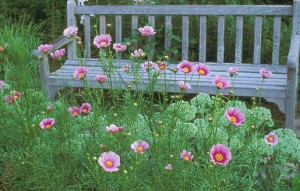
Cosmos takes center stage in a sweet cottage garden scene
This spring I’m giving a series of lectures about cottage gardening, focusing primarily on a very particular cottage garden I designed and built starting in 2000. At nine years of age, it’s had plenty of time to mature and evolve. Many good gardening lessons can be drawn from it, and I’ll be sharing them with you over the coming months.
If you’re in (or plan to be in) southern New England this spring, check out my lecture schedule to see if you can’t fit one into your plans. Most of them are free, and you can’t do better than that!
To get things started, I’ll just say a few words about what a cottage garden is. The origins of the cottage garden go back hundreds of years to a time when most people grew a significant amount of their own food and made a great deal of their own household products—from soaps and dyes to medicines—mostly from plants. Cottage gardens are named for the country cottages around which they were found. Although cottage gardens as a phenomenon certainly weren’t restricted to the British Isles, we did inherit the cottage gardening tradition primarily from the British by virtue of our shared history.
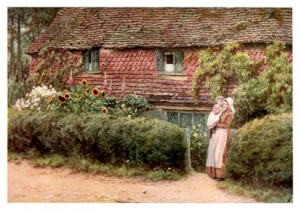
An artist's depiction of a traditional British cottage garden
Several things characterized the traditional cottage garden. It was on the small side, informal and not “designed” in anything like the modern sense of the word; it was a garden belonging to a person of modest means; it was a mix of flowers, vegetables and herbs (although the word “herb” meant something different then—more on that later); the plants in it were procured cheaply, usually in the form of passalong cuttings, divisions and seeds from friends and family; and it was densely packed with plants in order to maximize the productivity of a limited space.
Today’s cottage gardens are often strictly ornamental, vegetables and herbs now having their source at the local grocery store. They can be large, upscale and filled with the most fashionable of exotic vegetation, or they can be spaces where every resident plant carries an association with a loved friend or relative who gave it as a gift. Despite these differences, cottage gardens still look a lot like their ancestors—a testament to the adaptability of a loosely defined garden style. In fact, the only real requirements for a cottage garden are that it have a blowsy, freewheeling look and a lot of different flowering things.
That’s all for now—I hope you’ll join me over the coming months as we look in depth at how to make captivating cottage gardens.

